Knowde Enhanced TDS
Identification & Functionality
- Chemical Family
- Polymer Name
- Technologies
- Product Families
Features & Benefits
- Labeling Claims
- Materials Features
- Tedlar® PVF Features in Aerospace Applications
DuPont™ Tedlar® protective film offers attractive, easy-to-clean, scuff-resistant surface protection to aircraft interiors. Tedlar® films are lightweight, have excellent conformability and offer superior resistance to harsh cleaners, chemicals and solvents, eliminating the need for repainting and reducing maintenance costs to help provide every passenger a fresh look on every flight.
The proven performance of Tedlar® film has made it the aircraft standard to which other materials used in the industry are measured. Tedlar® film meets or exceeds Federal Aviation Administration (FAA) and European Union Aviation Safety Agency (EASA) standards.
Design flexibility
Tedlar® film gives airlines maximum interior design flexibility to create passenger areas that are attractive and easy to clean. Tedlar® films can be embossed and printed, enabling the use of many unique texture designs and can be tailored to various gloss levels, thicknesses and finishes.
Fade resistant
Tedlar® film is available in an array of fade-resistant colors to match the look of your aircraft. If necessary, the colors can be matched long after the initial installation. Transparent Tedlar® film is also available as an excellent overlaminate for printed patterns.
- Tedlar® PVF Features in Cleanability and Disinfection
DuPont™ Tedlar® is a versatile polyvinyl fluoride (PVF) film. For more than 60 years, Tedlar® PVF films have provided durable, longlasting protection and timeless esthetics to many types of surfaces that are subjected to harsh environments. Available as transparent film or in a variety of colors and gloss levels, it is typically applied to the surface of other materials to provide added durability, cleanability and chemical resistance. Its applications span a range of industries, including transportation, aerospace, building and construction, graphics and signage, electronics and photovoltaics.
Polyvinyl fluoride film is naturally transparent and flexible, enabling its use without addition of any co-resins or plasticizers. It is formulated to provide a desired color, gloss or special functionality using only inert additives that do not sustain the life of microorganisms like mold, mildew, fungus and bacteria. When sterilization is required to remove residual microbes, the films have extremely high resistance to degradation by chemicals and disinfectants for even the most rigorous disinfection protocols.
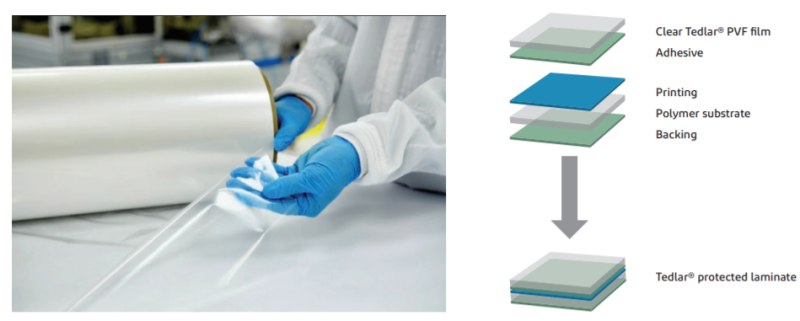
Figure 1: Picture of Tedlar® PVF film and a schematic of a laminated structure including Tedlar® as a protective surface glazing
- Tedlar® for Architectural Sheet Metals
In coastal and tropical/sub-tropical natural environments with high temperature, high humidity and especially high salt spray, pollution brought by industrial development is gradually evolving into a highly corrosive atmospheric environment. Metals exposed to these environments for many years are highly susceptible to corrosive damage caused by moisture, oxygen and corrosive substances (such as impurities, acids, salt ions, dust and surface deposits).
Tedlar® film consists of 100% fluorocarbon resin without the addition of plasticizers such as acrylic acid (also known as acrylic or polymethyl methacrylate [PMMA]). The chemical stability and aging resistance of fluorocarbon resins ensure the excellent weatherability of Tedlar® . In addition, Tedlar® film for buildings and construction has been subjected to biaxial stretching to improve mechanical, optical and barrier film properties. The surface of the film is resistant to pinholes, cracks and other abrasions, and provides long-term effective protection for the metal substrate.
The excellent weatherability and corrosion resistance of Tedlar® film laminated metal sheets have been proven in numerous practical application cases over the past 30 years.
- Tedlar® PVF in Healthcare Environment
Interiors
- Mold and bacterial resistant
- Solvent resistant
- Flame resistant
- Long term protection
- Eco-friendly
- Endurable style
- Cleanability
- Chemical resistant
- Stain/graffiti resistant
- Excellent flame & smoke rating
- Excellent formability
- Heat sealable
- Ink & print receptive
Exteriors
- UV & weather stability
- Chemical resistance
- Stain / dirt resistant
- Range of surface gloss
- Low toxicity & volatiles
- Bendability
- Low gas/vapor permeability
- Temperature stability
- Color stability
- Sound transmitting
- Tedlar® PVF Features in Architectural Applications
- Resistant to weather, ultraviolet (UV) rays, fading and corrosion
- Pliant and easily molded
- Impervious to harsh chemicals and pollution
- Easy to clean
- Resistant to mold, mildew and bacteria
- Environmentally safe
DuPont™ Tedlar® protective film helps extend the look and life of your design, even in the most extreme environments. From severe weather to harsh chemicals, Tedlar® protective film provides long-term durability and performance. Tedlar® protective film can easily be applied to a range of surfaces, providing the flexibility to design your way, and the surface performance to keep it that way.
Low maintenance costs : In addition to exceptional protection from the elements, Tedlar® provides an impervious barrier against stains and scuffs, making them easy to wipe away. And because it can stand up to the harshest industrial cleaning products, including bleach, Tedlar® protective film helps keep your designs looking their best.
Resistant to mold and mildew : Tedlar® protective films do not support mold or mildew growth, providing superior surface protection in even the most extreme and high-traffic environments. Additionally, Tedlar® won’t support bacterial growth, so it’s safe for you and for the environment.
Fade resistant: Tedlar® PVF is available in both transparent and opaque pigmented film. The color uniformity and fade resistance of pigmented Tedlar® protective film allows it to hold its color and maintain its original appearance for years. Transparent films allow long-term light transmission while greatly minimizing cracking, yellowing or fogging of the laminate.
Durable
Tedlar® film has delivered excellent weatherability and proven protection in a number of practical applications.
Japanese steel sheet plant
Founded in 1984, this steel sheet plant expanded its workshops in 2010 and installed Tedlar® film laminated steel sheets of the same color. As shown in the figure, the newly installed steel sheet has almost no difference in color and appearance compared with the steel sheet that has been used for 26 years.
In addition, although the plant is located in the coastal area, there is no obvious corrosion on the edges of the steel siding and at the screw holes, which indicates that the Tedlar® film provides effective protection for the steel sheet.
Chaoyang Park Tennis Center, Beijing, China
Laminated with Tedlar® film, this tennis center’s air bearing membrane roof has remained almost unchanged in color.
Okinawa Thermal Power Plant, Japan
Founded in 1986, this thermal power plant is located in the coastal area of Okinawa, less than 500 meters from the coastline. The high salt spray environment along the coast and the smoke in the power plant are very corrosive to buildings, especially metal sheets. After 27 years of erosion by wind and rain, the steel sheets protected by Tedlar® film revealed no signs of rusting at the edges and seams. Moreover, the film maintained an ultra-high color stability. After 27 years of use in the coastal environment, there is no obvious discoloration and chalking. There is almost no color difference compared with the sample left inside the plant in 1986.
Stylish
With ultra-low color differences, a smooth and fine texture and excellent formability, Tedlar® film is stylish and esthetically pleasing from installation until its removal. Its matte surface finish even prevents light pollution.
- Metal roofing panel : Tedlar® film’s lot-to-lot color reproducibility is controlled to a delta of <0.5.
- Even & delicate surface finish : With an even surface finish, Tedlar® film prevents uneven thickness and pinholes caused by factors in processing.
- Prevents light pollution : With a matte finish on the surface, Tedlar® film maintains an attractive esthetic without allowing light pollution.
- Ease of machining and shaping : Tedlar® film is pliable and ductile, allowing for excellent processability and application.
Building façade in Yokohama, Japan
In 1983, a building in Yokohama, Japan, installed a façade using Tedlar® PVF film. The film is matte, with an even and delicate surface finish. Compared to the Tedlar® standard color chart, the exterior wall surface has almost no difference in color after three decades of use.
Building in Tokyo, Japan
In 1986, a building in Tokyo, Japan, applied Tedlar® PVF to its exterior walls. Due to the complexity of the wall shape, Tedlar® film—with its easy-to-use machining and shaping properties—was the ideal choice. After more than three decades of use, the wall has almost no difference in color.
Easy to Clean
Non-sticky and stain resistant, Tedlar® film can withstand all types of dirt and grime. Chemically inert, the film can be cleaned with various cleaning agents and requires little maintenance.
Tedlar® is stain resistant and chemically inert, so it can be completely cleaned with a cleaning agent, even when exposed to stubborn stains such as spray paint or caulking compound. Other finishes, such as fluorocarbon paint, may be damaged in cleaning due to poor chemical inertness.
- Non-sticky and stain resistant : Tedlar® film resists all types of dirt, including bird droppings, water marks, paint, cooking fumes, grease, dust, acid rain and more.
- Chemically inert : Tedlar® film can stand up to a wide variety of detergents and strong solvents to remove stains such as asphalt, tar, grease, paint or caulking compound.
- Self-cleaning : Contaminants can be easily washed away by rain water, keeping the building’s appearance fresh and new, and reducing cleaning and maintenance costs.
Pedestrian bridge in Yokohama, Japan
Built in 1990, this pedestrian bridge in Yokohama, Japan, still remains esthetically pleasing after several decades of use. Tedlar® metal lamination was attached as a decorative panel to the side and bottom of the pedestrian bridge. Even today, the dust, moss and other stains on the Tedlar® surface are still very easy to clean, keeping the decorative surface clean and beautiful.
Safe & Environmentally Friendly
Tedlar® film is non-flammable and non-reactive, and it doesn’t support bacterial growth. Additionally, it produces minimal volatile organic compound (VOC) emissions during processing.
- Excellent fire resistance: Tedlar® film is a component of structures that pass safety requirements for aircraft-grade fire resistance and low smoke toxicity. It is also recognized as a non-flammable material in Japan (NM0717, NM1553). Lamination onto metal sheet provides excellent fire resistance and low smoke toxicity.
Applied to the interior of aircraft cabins - Exceptional bacteria resistance : Tedlar® film does not support the growth of bacteria, mold and mildew. It is especially suitable for places that require a high level of cleanliness, such as hospitals, hotels, restaurants and shopping malls.
Applied to sterile operating rooms in hospitals
- Unique Values for Healthcare Interiors
Mold and Bacteria Resistance
- Tedlar® surface does not provide nutrients to enable mold or bacteria growth, certified by MicroStar Labs, ASTM G21 and JIS Z 2801. UL 2824
- Mildew growth resistant with zero additive
Flame Resistance
- Non-flammable and low smoke toxicity, used in aircrafts; Exceed the ASTM E84 Class A rating.
- Meet Grade B1, GB8624-2012, Chinese regulation
Long-term Protection
- Provide a protective barrier against most staining agents and cleaning solvents, including: bleach, alcohols, ketones (acetone, MEK) and even strong acids and alkalis.
Easy Cleaning
- Stain resistant to various species in healthcare environment, easy to clean completely after 24h
Safe and GREEN
- Greenguard GOLD certificate
- Designers & Architects can earn LEED points and customers get environmentally certified materials & stylish, healthier indoor spaces.
Chemical Resistance
- Solvent resistant
Endurable Style
- Prevent color fade
- Scrub resistant, ideal for high traffic areas
- Colorful Enduring Empowering
Tedlar® PVF film provides a long-lasting finish to a wide variety of surfaces exposed to harsh environments. The color uniformity and fade resistance of Tedlar® allows it to hold its color and maintain its original appearance for decades.
- Tedlar PVF Film Background
DuPont Tedlar is a versatile film made with a PVF polymer. DuPont invented PVF polymer in the 1940s, and by the 1950s began developing products based on this material. DuPont Tedlar provides durable, long-lasting protection and decoration to many types of surfaces in a variety of industries including transportation, aerospace, building and construction, graphics and signage, and photovoltaics. Tedlar PVF film is strong and flexible, has excellent resistance to chemicals, aggressive cleaning agents, resists stains and graffiti, is easy to clean, and slows the growth of mold and mildew.
For more than 60 years, Tedlar PVF film has been recognized as the high-performance standard in the wide range of industries it serves, due to its demonstrated durability in harsh operating environments. Tedlar is the only film with decades of proven field performance, from protecting buildings’ exteriors to providing long-term reliability in solar panels.
This vast range of Tedlar film applications means that many people have interacted with the film unknowingly. Because Tedlar can be produced in colored or clear film, passengers on an airplane could be resting their head on a cabin interior wall or window which is protected by Tedlar or see a bus stop sign protected by the anti-graffiti Tedlar PVF Graphics Protection film.
- Tedlar PVF Films for Healthcare
The use of Tedlar PVF films in the healthcare industry dates back to the 1980s, primarily as an integral protective barrier film in commercial wallcoverings.
Tedlar PVF films bring a unique value to healthcare surfaces for many reasons:
Superior chemical resistance
Tedlar PVF films have demonstrated exceptional resistance to harsh chemicals without degradation of their esthetic and mechanical properties. This is very important to ensure the protected walls, furniture and other surfaces are able to maintain their original appearance and integrity throughout their useful lifetime. Tedlar retains its form and strength when exposed to a large variety of chemicals, even under extreme conditions. At ordinary temperatures, the film is not affected by most common solvents, including hydrocarbons and chlorinated solvents. It is impermeable to greases and oils.
Exceptional cleanability
Tedlar PVF films have also demonstrated excellent chemical compatibility with many of the top cleaners and disinfectants used in healthcare today, including bleach and peroxides. Additionally, Tedlar films have demonstrated resistance to many of the toughest staining agents which are commonly found in the healthcare environment. In hospital and healthcare settings, there are various stains which are persistent and difficult to remove. Testing of these stains commonly found in critical areas of healthcare settings, on Tedlar PVF, wall plastic PVC materials, ethylene vinyl alcohol (EVOH), polypropylene and melanine panels, showed that difficult stains could be either completely removed or mostly removed from Tedlar PVF surface even after aging for 15 days.
A further cleanability test of Tedlar PVF films is shown in Figure 2. In this test, a variety of potential staining agents were placed on the surface of Tedlar film for 24 hours prior to cleaning. The residue was then wiped first with a dry cloth, followed by a wet cloth, then mild detergent (bleach or liquid soap), moderate household solvents (isopropyl alcohol), and finally, if needed, stronger solvents (acetone, toluene, MEK, soy-based cleaners). Each item in the table is marked if the stain was fully removed (R) with no trace, partially removed with slight shadow (S) after cleaning, or if the stain was not removed (NG).
Minimizes growth of mold and mildew
Since – unlike some competitor materials – Tedlar PVF films do not contain additives such as plasticisers, which can act as a nutrient source for fungi and microorganisms, studies have demonstrated that Tedlar PVF films do not support the growth of mold and mildew. In fact, the DuPont Tedlar Wallcoverings product line has demonstrated UL Environmental Claim Validation for Mold Resistance as tested to ASTM G21, UL 2824.
Minimizes bacterial growth
As detailed above, Tedlar films do not produce nutrients which may be conducive to bacterial growth. PVF films do not support the growth of bacteria according to ISO846 - Part C-2019.
Durability factors important to overall performance
Surfaces protected by Tedlar do not fade in color or show signs of wear and tear, even with aggressive cleaning and scrubbing. Tedlar PVF films have demonstrated years of real-life application performance standing up to some of the toughest of environments. A surface’s ability to withstand occasional events, such as a hospital bed or a patient trolley hitting the side of a protected wall or nurse’s station, is very important to a product’s performance. Tedlar PVF films are used in laminate composite structures and these structures become an integral part of the final product, whether this is a piece of furniture or wallcovering.
Applications & Uses
- Applications
- Plastics & Elastomers End Uses
- Tedlar® PVF for Aerospace Applications
- Interior ceiling and sidewall decorative panels
- Window shades
- Stow bins
- Lavatories and galleys
- Ceiling panels
- Personal service units (PSUs)
- Bulkhead partitions
- Insulation barriers
- Moisture barriers
- Cargo bin liners
- Aircraft wire markers
- Composite noise panels
- Partitions
- Monuments
- Closets
- Landing Gear Bay
- Cargo Protection
- Labeling
- Composite Release
- Composite Protection
- Current Use Case: Tedlar® in Commercial Passenger Aircraft
- Tedlar® has protected the interiors of aircraft since 1964 and continues to be the industryrecognized standard today.
- Tedlar® was chosen in commercial aircraft due to its high standard of non-flammability. It is certified by FAA and EASA with excellent fire resistance.
- Tedlar® continues to be used because of its durability. The interior of aircraft see thousands of customers over years and are able to stay looking clean year in year out.
- Tedlar® PVF for Architectural Applications
- Wallcoverings
- Residential and commercial roofing, siding, trim and accents
- Formed or flat metal building panels
- Flexible laminates for air-inflated structures, canopies, awnings and stadium domes
- Indoor and outdoor fabrics
- Curtain walls
- Healthcare facility surfaces
- Pipe and vessel jacketing
- Surface Protection from All Angles
Tedlar® film can be laminated on various substrates to create different applications for interiors
- Wallcoverings (wallpaper or laminated panel)
- Door and window
- Ceiling panel
- Floor materials
- Furniture surface
- Acoustical panel
PVF film or wallcovering laminated on different substrates:

- Using Tedlar PVF Films in Healthcare Environments
Tedlar PVF films can be used with several applications in healthcare settings to protect caregivers and patients sharing the space. Tedlar can be used on ceiling tiles, wall panels or on bleach-cleanable Tedlar Wallcoverings. Tedlar helps protect and preserve the surfaces which are most important to maintaining high quality hygiene in areas where people interact the most. Tedlar PVF films help preserve these surfaces from breaking down over time with constant cleaning. DuPont is passionate about collaborating with partners to provide new solutions for the healthcare industry, especially during times of heightened cleaning efforts. In responding to the most immediate market needs, Tedlar PVF film product concepts are being adapted to include curtain walls, roller shades and patient tabletops.
Properties
- Chemical Resistance
- Color
- Flame Rating
- Physical Form
- Mechanical Properties
- Physical Properties
- Thermal Properties
- Mechanical Properties of Tedlar® Films
Tedlar® PVF film is strong, flexible and fatigue-resistant. Its resistance to failure by flexing is outstanding. Since the surface esthetics are imparted by the film formulation, the esthetics do not change when stretching the film for most film types.
The mechanical properties of Tedlar® depend on the specific film, including the amount of orientation and the additives or pigments in the film. The most important factor in the mechanical properties of Tedlar® is the amount of molecular orientation. The stress versus strain curve for film with various levels of orientation are shown in Figure 1. Highly oriented Type 1 films have the highest strength and lowest elongation at break. Balanced Type 3 films have a moderate level of performance. Low orientation Type 5 films have the lowest strength and highest elongation to break, making them exceptionally formable. Unoriented Type 8 films, also known as ‘SP’ films, have approximately the same strength as Type 5 films but with much greater elongation to break, making them exceptionally formable. The Type 8 films also have an extended region of elongation at constant stress, making them prone to elongation by necking rather than uniform stretching.
Aside from orientation, other film properties such as additives, pigments, and thickness can have small effects on the mechanical properties of the film. The typical mechanical properties of some white and clear films, both 1 and 2 mil thick. Minor variations in strength and elongation result from the composition and thickness of a specific film type. It is also important to note that PVF films contain no plasticizers, so mechanical properties remain stable through thermal processing and aging.
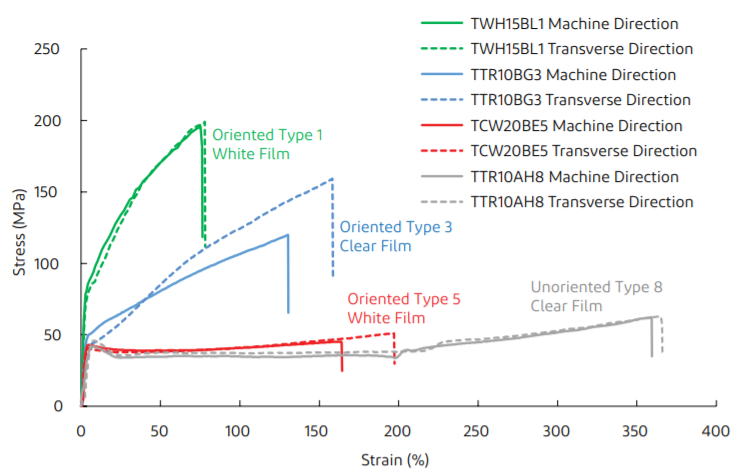
Figure 1: Typical stress versus strain curves for a variety of film orientations. Lower orientation causes lower strength but greater formability.
| Value | Units | Test Method / Conditions | |
| Tensile Modulus - MD | 2.2 | GPa | ASTM D882-18 |
| Tensile Modulus - TD | 2.1 | GPa | ASTM D882-18 |
| Yield Stress - MD | 36 | MPa | ASTM D882-18 |
| Yield Stress - TD | 31 | MPa | ASTM D882-18 |
| Yield Strain - MD | 2 | % | ASTM D882-18 |
| Yield Strain - TD | 1.9 | % | ASTM D882-18 |
| Ultimate Strength - MD | 103 | MPa | ASTM D882-18 |
| Ultimate Strength - TD | 157 | MPa | ASTM D882-18 |
| Elongation at Break - MD | 131 | % | ASTM D882-18 |
| Elongation at Break - TD | 154 | % | ASTM D882-18 |
| Value | Units | Test Method / Conditions | |
| Coefficient of Friction (Film on Metal) | 0.18 - 0.21 | — | ASTM D1894 |
| Density of Clear Film | 1.4 | g/cc | ASTM D1505 |
| Falling Sand Erosion (on PET Backing) | 04-Aug | L/µm | ASTM D968 |
| Falling Sand Erosion (on PET Backing) | 4-8 | L/µm | ASTM D968 |
| Impact Strength | 45 - 89 | J/mm | ASTM D3420 |
| Moisture Absorption (for most types) | max. 0.5 | % | Water Immersion |
| Optical Transmission of Clear Films | 93 | % | ASTM D1003 |
| Refractive Index of Clear Films | 1.46 | — | ASTM D542 |
| Shore Hardness | D60 - D70 | — | ASTM D2240 |
| Strain at Break | 90 - 250 | % | ASTM D882 |
| Tear Strength (Initial) | 100 - 200 | N/mm | ASTM D1004 |
| Tear Strength (Propagated) | 5.9 - 24 | N/mm | ASTM D1922 |
| Tensile Modulus | 2.1 - 2.6 | GPa | ASTM D882 |
| Ultimate Strength | 55 - 110 | MPa | ASTM D882 |
| Yield Strength | 34 - 41 | MPa | ASTM D882 |
| Value | Units | Test Method / Conditions | |
| Coefficient of Thermal Expansion | 5 - 10 x 10^-5 | m/m·K | ASTM D696 |
| Lower Glass Transition Temperature | 15 to -20 | °C | Various |
| Peak Melting Temperature | 190 - 210 | °C | ASTM E1269 |
| Relative Thermal Index - Electrical Strength | 140 | °C | UL 746B |
| Relative Thermal Index - Mechanical Impact | 120 | °C | UL 746B |
| Relative Thermal Index - Mechanical Strength | 125 | °C | UL 746B |
| Specific Heat Capacity | 1.0 - 1.1 | kJ/kg*K | ASTM E1269 |
| Temperature Range (continuous use) | -70 to 105 | °C | — |
| Upper Glass Transition Temperature | 40 - 50 | °C | Various |
Regulatory & Compliance
Technical Details & Test Data
- Metal Lamination
Product structure and processing flow
Tedlar® film is laminated onto a metal substrate using a special adhesive invented by DuPont based on a hot laminating process. The process and product structure are similar to those of a fluorocarbon coil coated metal sheet. The figure below illustrates the differences between Tedlar® film lamination and fluorocarbon baking coating.
Structural comparison of Tedlar® film laminated steel sheet vs. sheet with fluorocarbon baking coating

Metal Lamination Process of Tedlar® film
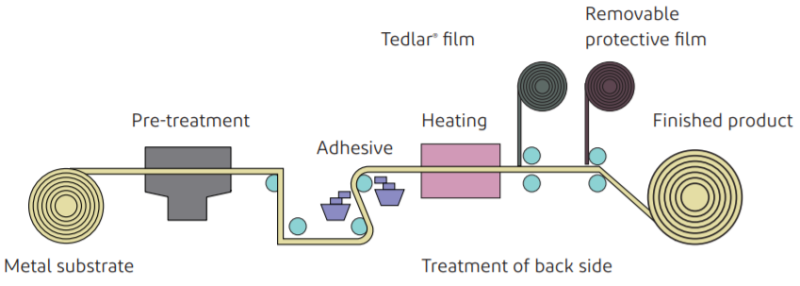
- Building Solutions
System solutions for building
Tedlar® film-based metal lamination
Tedlar® film-based metal lamination provides a guarantee of more than 30 years of service life for the roofing of any new project.
Product structure example
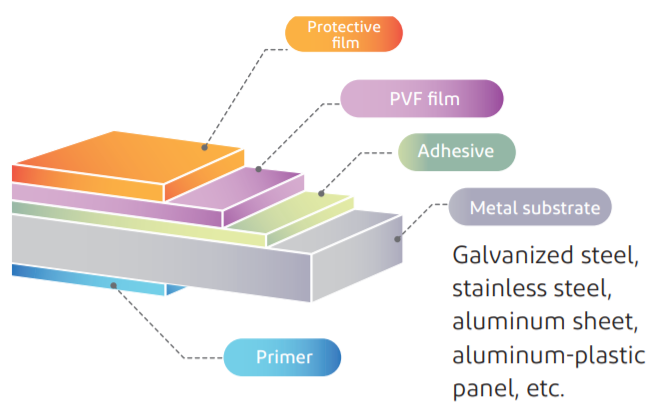
Tedlar® metal lamination product structure
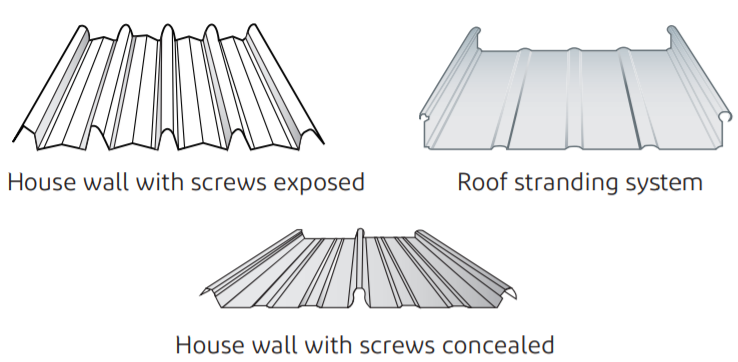
Metal roof panel structure diagram
Composite metal sheet with Tedlar® film interior finish
Tedlar® film interior finishes not only have the delicate texture of fabric, but also have excellent properties such as fire-, stain- and corrosion-resistance and ease of cleaning. Organic combination with steel sheet makes the Tedlar® interior finish suitable for medical environments.
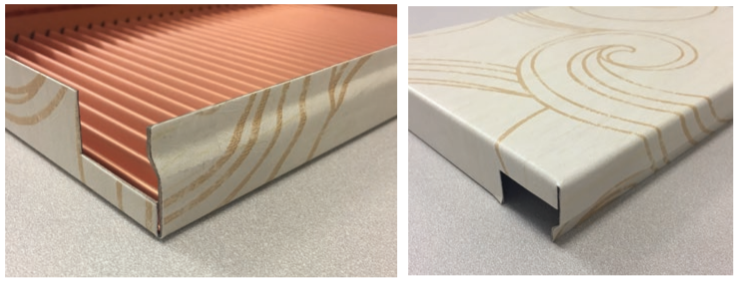
Membrane fabric materials laminated with Tedlar® film
Tedlar® film can be laminated with various coated fabrics to form membrane fabric structures at much lower construction costs than steel. With excellent weatherability and dirt-shedding properties, membrane fabric is a cost-effective material for buildings like stadiums, convention centers, commercial facilities and transportation hubs.
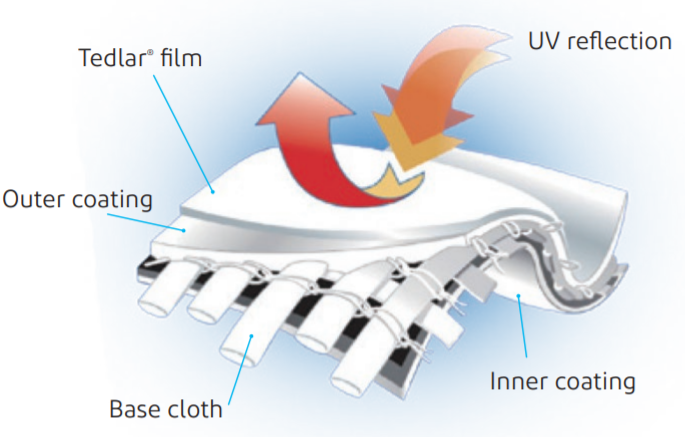
Composition of membrane fabric materials
- Cleanability of Tedlar® PVF Films
The cleanability of Tedlar® originates from its highly inert chemistry. The incorporation of fluorine into the monomer unit draws electron density away from the linear carbon backbone, effectively creating stronger bonds throughout the entire polymer chain. As a result, the PVF resin does not dissolve in any known solvent at room temperature, does not absorb water and is inert to attack by strong acids and alkalis, providing the highest level of resistance to chemicals, pollutants, corrosive agents, cleaners and disinfectants. The chemical resistance also prevents the ingress of staining agents and enables the removal of stains or graffiti from the surface without ghosting, using a wide range of cleaners and solvents.
Tedlar® is an excellent choice for use in high traffic areas that require frequent cleaning and disinfection, such as hospitals, healthcare centers, aircraft and other public transportation. The cleanability ensures that the intended esthetics are maintained for many years despite high levels of use. The chemical resistance ensures that the widest variety of disinfectants can be used to kill bacteria, viruses, fungi and other pathogens without adversely affecting the material or the surface esthetics.
Tedlar® PVF films have excellent resistance to stains and are easily cleanable. They are hydrophobic and impermeable to greases and oils, keeping most staining agents on the surface of the film where they can be easily removed. In fact, most dirt and debris can be easily removed with just soap and water. A cleanability test of Tedlar® PVF films is shown in Table 1. In this test, a variety of potential staining agents were placed on the surface of Tedlar® film and remained for 24 hours prior to cleaning. The residue was then wiped first with a dry cloth, followed by a wet cloth, then mild detergent, moderate household solvents like isopropyl alcohol and finally, if needed, stronger solvents such as acetone, toluene or MEK. Each item in the table is marked if the stain was fully removed (R) with no trace, partially removed with slight shadow (S) after cleaning, or not removed (NG).
Staining Agent Dry Cloth Wet Cloth Soaps and Household Detergents Moderate Household Solvents Commercial Cleaning Solutions and Stronger Solvents Food and Drink Butter S R Catsup NG S R Chocolate Syrup S R Coffee S R Grape Juice S R Mustard S R Orange Juice S R Red Wine S R Tea S R Worcestershire Sauce S R Household Items Ball point pen NG NG S S R Black Crayon S R Brown Shoe Polish NG NG R Calamine Lotion S R Lipstick S S R Oily Pen NG S R Permanent Marker NG NG S S R Spray Paint NG NG NG S R Chemicals Acetic Acid, Glacial R Acetone R Asphalt NG NG S R Betadine S R Bleach R Brake Fluid S R Citric Acid, 10% R Ethyl Alcohol R Ethylene Glycol R Gasoline R Hydrochloric Acid, 20% R Iodine R Mercurochrome NG S R Methyl Ethyl Ketone R Nitric Acid, 10% R Sodium Hydroxide R Sulfuric Acid, 30% R Stomach Acid NA R Human Sweat NA R Urine NA R Table 1: Typical stain resistance and cleaning of Tedlar® films
 Figure 2: Common, challenging stains are easily removed from surfaces protected with Tedlar® PVF film.
Figure 2: Common, challenging stains are easily removed from surfaces protected with Tedlar® PVF film.Stains come in all kinds of forms and can be generated by food and drinks, household items and even chemicals. Each stain removal may require a different cleaning agent and each cleaning agent has a different chemical makeup. Since Tedlar® PVF films have exceptional compatibility with many aggressive solvents, an entire range of cleaning products can be used without worry of permanent material damage. This includes even the harshest cleaners found in industrial applications for tough stain and graffiti removal. Figure 2 shows the progression of what is required to clean four common, yet very challenging stains that could occur, both with and without the presence of a Tedlar® protective film.
As an extreme example of a staining agent, the same volume of iodine solution was placed on the surface of commercial wallcovering, both with and without the protection of Tedlar® PVF film and left for an hour. The results are shown in Figure 3. The iodine was then wiped off with a wet cloth, and then wiped again with pure acetone. The hydrophobic Tedlar® PVF film prevents the waterborne iodine solution from soaking and staining the film, while the unprotected wallcovering is severely discolored. The Tedlar® film can be fully cleaned with acetone, while the unprotected wallcovering is permanently damaged.
Surfaces protected with Tedlar® should be cleaned first with a cloth, soap and water or household cleaning solutions before they are disinfected. If this procedure is not sufficient to remove a stain, then moderate to stronger solvents may be used (such as ethanol or acetone). The list of common stains in Table 1 and their behavior towards cleaning solutions may serve as a guide to select the right cleaning procedure.
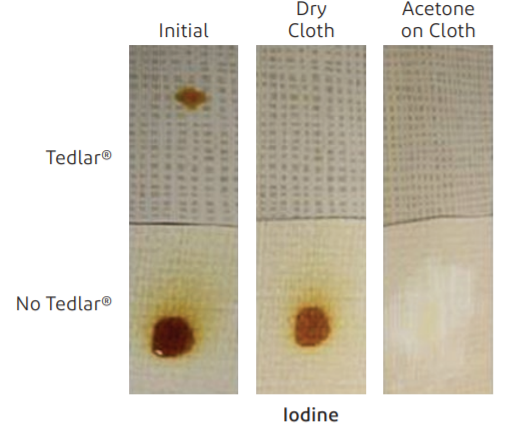
Figure 3: Enhanced chemical and stain resistance is imparted by covering a surface with Tedlar® PVF film. Here, a wallcovering film is made compatible with both iodine and acetone.
Disinfectant Rating Oxycide: Hydrogen Peroxide + Peroxyacetic Acid E Oxivir TB: Hydrogen Peroxide (0.5%) E Clorox Healthcare bleach solution (10%) E Virex II 256: Quaternary ammonium E Hand Sanitizer – 70% IPA E JF2 Glance: Non-ammoniated E JF3 Stride Citrus Neutral Cleaner E Table 2: Resistance of Tedlar® PVF film to common disinfectant solutions. The ‘E’ rating denotes that there was no perceptible change of appearance or mechanical properties when 2.5 mL were deposited on the surface each day for five days and cleaned off only at the end of the test.
- Disinfecting Tedlar® PVF Films
While cleaning removes dirt, debris and other matter from the surface of the film, it often does not kill bacteria, viruses, fungi, and other pathogens which can persist on the surface. For many public areas and especially healthcare settings, proper disinfection after cleaning is vital to ensuring public safety and controlling the spread of disease. Disinfection is most often performed by exposing surfaces to chemical disinfectants, but sometimes is also supplemented with exposure to ultraviolet (UV) light.
When used on Tedlar® film, chemical disinfectants should be employed as described on their labeling. Due to the chemical resistance of Tedlar®, a wide range of disinfectants can be used without worrying about damaging the surface of the material. Table 2 demonstrates the outstanding resistance to common disinfectant solutions after five days of continuous contact. The surface exhibited no cracking, delamination or changes in color or gloss
In addition to chemical disinfection, UV light is occasionally used as a supplement to chemical disinfection. Since pure polyvinyl fluoride film does not absorb ultraviolet light, it is exceptionally stable to these exposures. To demonstrate this, pigmented Tedlar® films were continuously exposed to 254 nm light using an Air Science UV Box, which contains three 60 W bulbs emitting 52.5 W of UVC radiation and maintains a chamber temperature of around 52 °C, for a total of 24 days. As shown in Figure 4, the film had minimal color change and retained all its mechanical properties after this intense exposure.
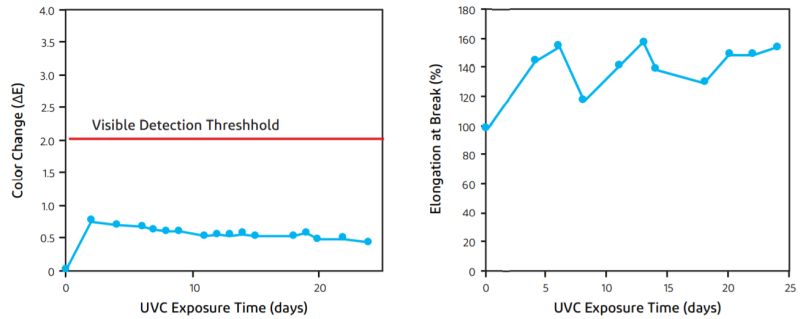 Figure 4: White Tedlar® film has minimal color change and maintains good mechanical properties even after 24 days of continuous exposure to intense 254 nm UVC light.
Figure 4: White Tedlar® film has minimal color change and maintains good mechanical properties even after 24 days of continuous exposure to intense 254 nm UVC light.For any application demanding the highest performance for cleaning and disinfecting, Tedlar® will protect your surface for many years. The extremely high chemical stability and durability, combined with the versatile esthetics, will provide a timeless appearance with unparalleled function.
- Improve the Corrosion Resistance and Service Life of Steel Sheets with Tedlar®
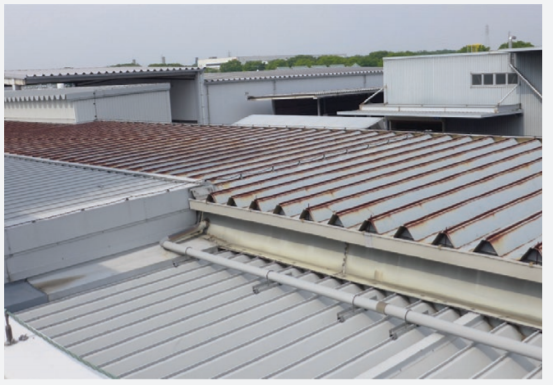
The picture above shows the rooftop of an industrial plant. The rooftop of the plant consists of two parts. The lower left is Tedlar® film laminated steel sheet installed in 1983, and the upper right roof is steel sheet coated with other material installed in the late 20th century. Although the roof sheets are the same shape and used in the same environment, the appearance of the steel sheet roofs coated with different materials shows a huge difference.
The steel sheet roof not laminated with Tedlar® has been severely rusted, while the Tedlar® film laminated steel sheet roof appears as durable as new after more than 30 years of use.
- Manufacturing Process
TEDLAR® film becomes a part of the wallcovering after being adhered at a high temperature; this means no peeling, or reapplying of the film, ever.
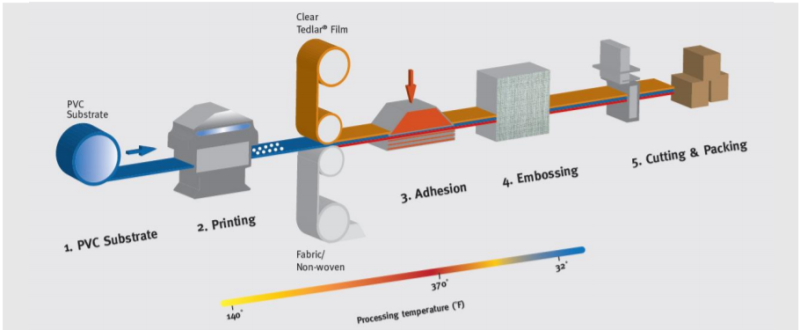
- Caulking Compound and Solvent Cleaning Test
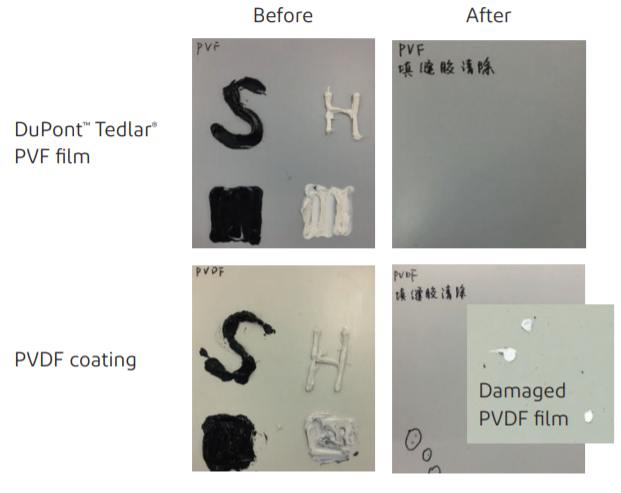
- Testing Results
- CCC-W-408D
Exceeds Type II classification for wallcovering, scrubability and abrasion test - ASTM E84 Class A
Flame and smoke spread - ASTM G21
- UL 2824
Mold and mildew resistant - JIS Z 2801
Bacterial resistant, against MRSA & E.coli test - RoHS Compliant
VOC restriction
- CCC-W-408D
- Chemical Resistance
Acid and alkali resistance – Test 1
To test the acid and alkali resistance, experimenters placed drops of concentrated sulfuric acid (98%) on the surface of samples of Tedlar® and PVDF for 24 hours.

Acid and alkali resistance – Test 2
After Tedlar® film laminated steel sheet (gray) and PVDF fluorocarbon paint coated steel sheet (blue) have been soaked in 5% hydrochloric acid and 5% sodium hydroxide solution for 30 days at room temperature, obvious bubbling appears on the surface of the PVDF-coated steel sheet, which indicates that the substrate is severely corroded, while the Tedlar® film laminated steel sheet is free of bubbling, delamination, etc., indicating that the Tedlar® film-protected steel sheet has excellent resistance to acid and alkali.
30-day acid and alkali soaking test
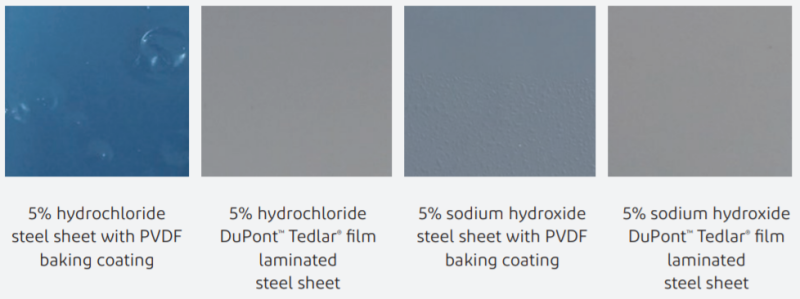
Salt spray resistance test
Tedlar® film and PVDF coating were exposed to salt spray for 2,000 hours.

High-temperature acid gas resistance test
This case is a steel roofing sheet project of the synthesis workshop in a chemical plant. Because high-temperature acid gas produced in the synthesis workshop causes severe corrosion to the original steel roof panel, the building owner must replace the roof every two years, which not only affects normal operation of the plant, but also poses a large production safety hazard. The plant replaced some of its roofing with Tedlar® film laminated steel sheets in 2016. After two years, the normal roof was still corroded and had to be replaced regularly, but the new roof panel using the Tedlar® film laminated steel sheets had no corrosion and remained esthetically pleasing.
Original steel sheet roofing
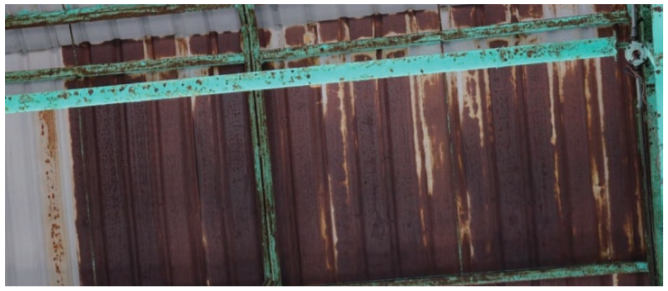
Tedlar® film laminated steel sheet roofing at far right
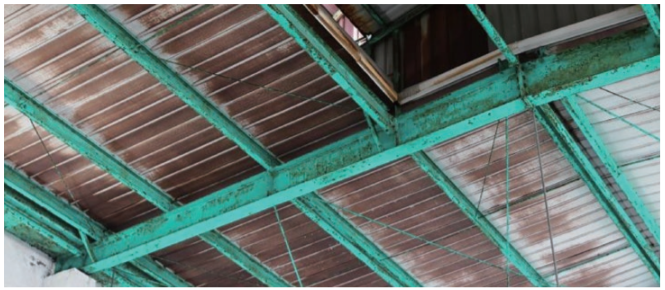
Chemical resistance of Tedlar® film
Experimenters immersed Tedlar® film in the following chemicals. The checkmarks indicate no significant change in tensile strength and ultimate elongation.
1-year immersion at room temperature 2-hour immersion at boil 31-day immersion at 75°C (167°F) Acids Acetic acid (glacial) ✓ ✓ Hydrochloric acid (10% & 30%) ✓ Hydrochloric acid (10%) ✓ ✓ Nitric acid (20%) ✓ Nitric acid (10% & 40%) ✓ Phosphoric acid (20%) ✓ Sulfuric acid (20%) ✓ Sulfuric acid (30%) ✓ Bases Ammonium hydroxide (12% & 39%) ✓ Ammonium hydroxide (10%) ✓ Sodium hydroxide (10%) ✓ ✓ Sodium hydroxide (10% & 54%) ✓ Solvents Acetone ✓ ✓ Benzene ✓ ✓ Benzyl alcohol ✓ 1,4-Dioxane ✓ Ethyl acetate ✓ Ethyl alcohol ✓ n-Heptane ✓ Kerosene ✓ Methyl ethyl ketone (MEK) ✓ Toluene ✓ Trichloroethylene ✓ Miscellaneous Phenol ✓ Phenol (5%) ✓ Sodium chloride (10%) ✓ Sodium sulfide (9%) ✓ Tricresyl phosphate ✓ - Mold and Bacteria Resistance
Certificated by
- ASTM G21, mildew-resistance achieving a rating of 0 or 1
- JIS Z2801, having antibacterial effectiveness for MRSA and E.coli
- GREENGUARD mold resistant per UL 2824
ASTM G21: Standard Practice for Determining Resistance of Synthetic Polymeric Materials to Fungi Legend for Growth Rating Observed Growth Rating None 0 Traces of Growth (less than 10%) 1 Light Growth (10% to 30%) 2 Medium Growth (30% to 60%) 3 Heavy Growth (60% to complete coverage) 4 Mold Resistance Test
Tedlar® PVF surface keeps mod-resistant Grade 1 after material aging.
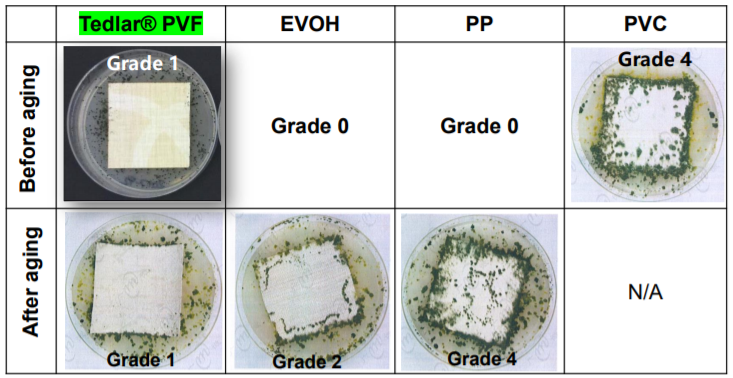
Aging condition: 85℃/85% humidity,1000 hours
- Weather Resistance
Accelerated aging and UV exposure test
As test results show, compared with the surface protection coatings such as acrylic and PVDF, Tedlar® film can better resist UV and acid rain, prevent dust buildup, and retain its thickness, color and gloss for a longer time, thus maintaining the building’s original appearance for longer.
Thickness
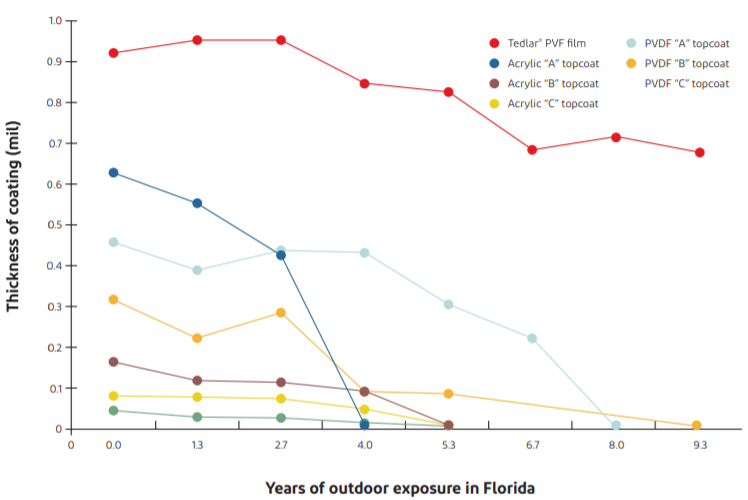 Gloss
Gloss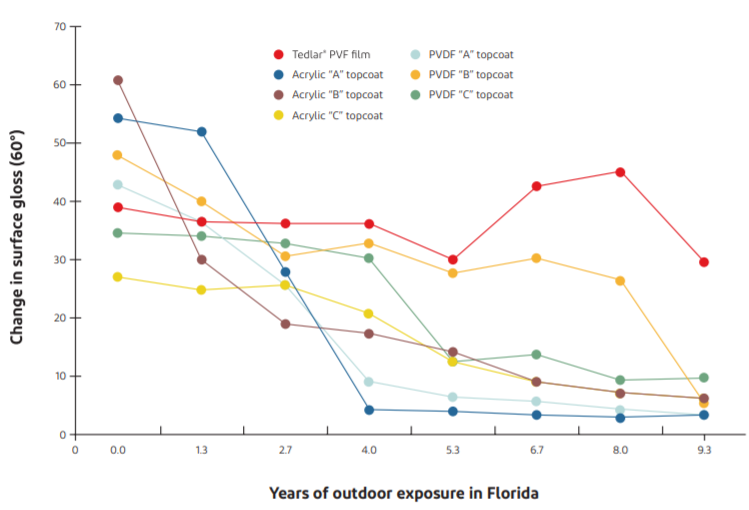
Color
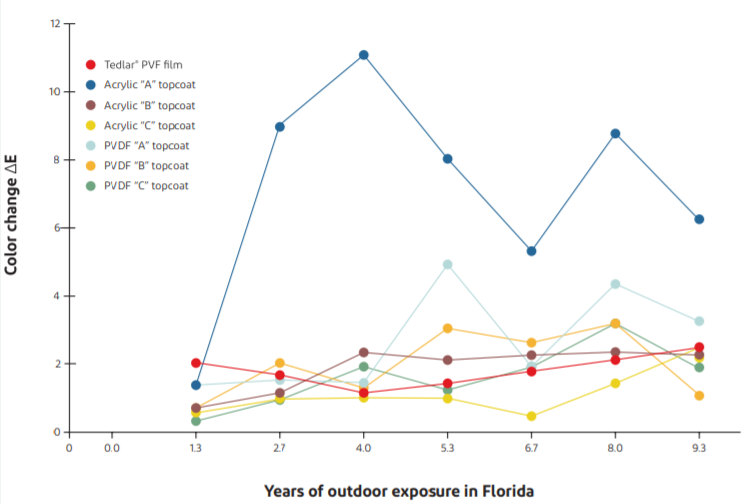
15-year Florida weather exposure test
Florida’s outdoor exposure field is recognized in the industry as a standard test site for assessing the weatherability of coatings. Ten-year Florida exposure is an important indicator of the American Architectural Manufacturers Association (AAMA) 2605, which is the highest weatherability rating for PVDF. Not only has Tedlar® film passed the 15-year Florida exposure test (color difference E < 4.5), but its color stability and weatherability rating is 50% higher than ordinary PVDF.
Tedlar® Florida weathering data: color change
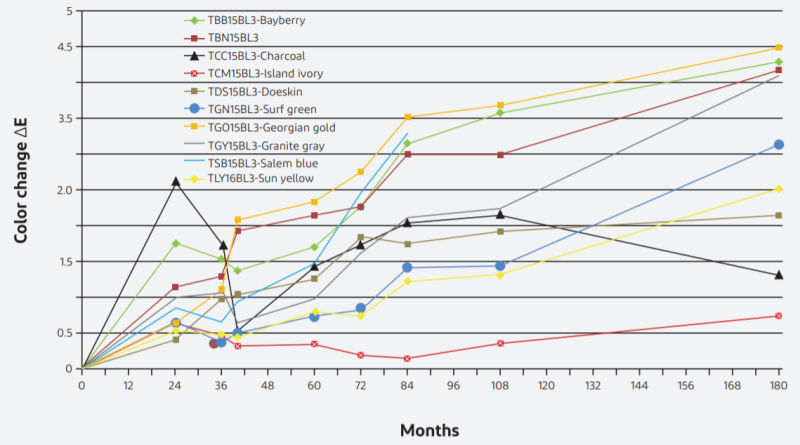
- Easy-cleaning Test I
For critical areas: Clinic/Patient room/Emergency point etc.
Before aging
Stains PVF Wall plastic PVC 1 Wall plastic PVC 2 EVOH PP Melamine panel Alcohol Alcohol Alcohol Alcohol Alcohol Alcohol iodophor 5 1 1 4 2 5 iodine 3 1 1 2 2 5 Methyl violet solution 5 1 1 4 4 4 Furacilin 5 5 1 - - - potassium permanganate 5 1 1 2 5 3 After aging
Stains PVF Wall plastic PVC 1 Wall plastic PVC 2 EVOH PP Alcohol Alcohol Alcohol Alcohol Alcohol Iodophor 5 1 1 2 2 iodine 3 1 1 2 2 methyl violet solution 4 1 1 2 4 Furacilin 5 3 1 - - potassium permanganate 5 1 1 2 3 Note:leaving stains 24hours before cleaning 5 = completely clean up;4 = slight stains left 3 = trace left; 2 = obvious stains left;1 = can not be cleaned up at all Aging test:15days aging test in 85℃ temperature and 85% humidity
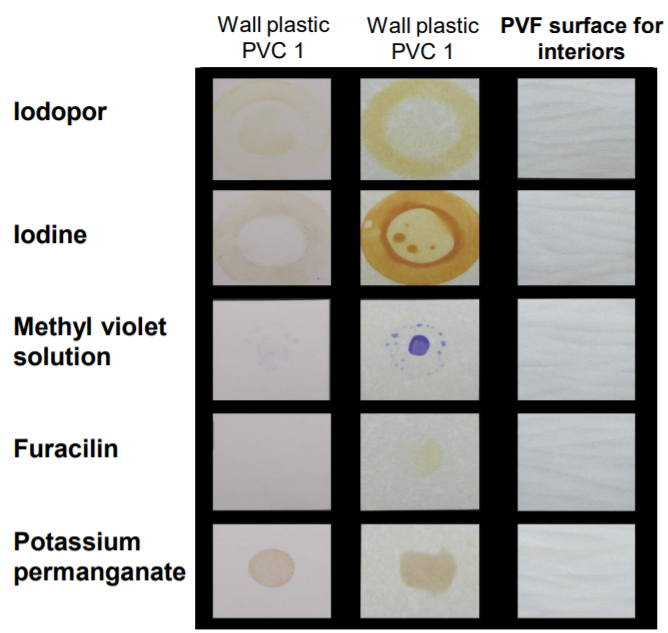
- Abrasion Resistance & Processability
Abrasion resistance test
Falling sand abrasion tests (ASTM D968) were conducted for 25-micron PVDF coating, 100-micron multilayer hot melt coating and Tedlar® film. The results show that the abrasion resistance of 37.5-micron Tedlar® film surpasses that of PVDF, but is identical to that of 100-micron multilayer hot melt coating.

0T bending test
A 180° 0T bending test (seen here at 40x magnification) shows that the PVDF-coated steel sheet has obvious cracks, while the Tedlar® film laminated steel plate shows no cracks. With film elongation up to 100%, Tedlar® has outstanding processability.

Processability Test
Tedlar® has an elongation of more than 100% and doesn’t crack after 0T bending, thus protecting the sheet from corrosion. It allows for complex sheet shaping during processability, with no discoloration at the bend. Additionally, there is no rusting on the punched steel sheet after a 2000-hour salt spray test.

- Tedlar® PVF Film Passes SGS Test
Test items Test methods Test contents Test results Remarks Weathering test (4000 hours) Weathering test CNS 15200-7-7 (2013) Appearance No cracking, blistering, etc. 1. Condition basis: refer to ASTM G154-12a Cycle 1
2. Illuminance: 0.89 W/m2 /nm
3. Light source type: UVA 340
4. Cycle conditions: 8h UV at 6°C BPT; 4h condensation at 50°C BPT
5. The sample is subject to 0T bending and 9.5 mm cupping before testingGloss CNS 10756-1 60° gloss retention (%) 100% Fading (color difference) ASTM D2244-11 4000 hours ∆E: 0.33 Chalking test ASTM D4214-07 Powdering degree Level 10 Damp heat resistance test (4000 hours) Damp heat resistance test CNS 11607 Appearance No cracking, blistering, etc. 1. Moisture and heat resistance test conditions: temperature: 50 ± 2°C, humidity: 95 ± 5% RH
2. The sample is subject to 0T bending and 9.5 mm cupping before testingGloss test CNS 10756-1 60° gloss retention (%) 98% Rusting grade rating ASTM D1654-92 Rusting grade Level 10 Salt spray test (4000 hours) Salt spray test CNS 8886 (2002) Appearance No cracking, blistering, etc. Salt spray test conditions
1. Experimental salt: analytical reagent
2. Saline concentration: 5 w/v% NaCl
3. Experimental water: pure water
4. Spray exposure zone temperature (°C): 35.0 ± 1.0
5. Spray amount (ml/h/80 cm2 ): 1.7 (avg.)
6. Supply air pressure (kgf/cm2 ): 1.0 (avg.)
7. Cleaning method: before the test— rinse with 38°C warm water, then wipe and dry
8. Solution pH: 6.8 (avg.)
9. Sample placement: vertical placement with an inclination of 15 degrees
10. Sample protection method: rubber seal on four sides
11. The sample is subject to 0T bending and 9.5 mm cupping before testingRusting grade rating ASTM D1654-92 Rusting grade Level 10 Acid and alkali resistance test Acid resistance test CNS 10757 (1995) 20% H2 SO4 , room temperature, 360 hours Immersion in acid solution without abnormality Alkali resistance test CNS 10757 (1995) 25% H2 SO4 , room temperature, 360 hours Immersion in acid solution without abnormality 1. The sample is subject to 0T bending and 9.5 mm cupping before testing Chemical resistance AAMA 2605-13 Nitric acid, after 30 minutes
Nitric acid, after 168 minutes
No significant change in color
No significant change in color
Physical property test Impact test CNS 10757 (1995) 160in.-lb No cracking, peeling, etc. Bending test ASTM D4145-83 (2002) 0T (no cracking, peeling, etc.) Cupping test CNS 10757 (1995) 10.49 mm Abrasion resistance (falling sand abrasion method) ASTM D968-05 (2010) Abrasion resistance (L/mil)(falling sand amount L) 127
191- Easy-cleaning Test II
For public areas: reception/lobby/waiting area
- All products were applied to TEDLAR™ Wallcovering and allowed to set for 24 hours. Utilizing the following methods, all products were successfully removed from the TEDLAR™ wallcoverings.
Dry Cloth Cleaning Wet Cloth Cleaning Detergent Solvent Acid Solutions* Coffee Ketchup Ball Point Pen Acetone Grape Juice Black Crayons Spray Paint Butanone Mustard Sauce Brown Shoe Polish Ethylalcohol Red Wine Lipstick Gasoline Tea Stains White Board Marker Glycol Worcestershire sauce Oily Pen Toluene Chocolate Syrup Asphalt Brake Fluid Mercurochrome Iodine Sodium Hydroxide *Acid solutions include: acetic acid, 10% nitric acid, 20% hydrochloric acid, and 30% sulfuric acid
- Abrasion Resistance
Type III surface protection in a type II weight.
- TEDLAR™ Wallcoverings offer exceptional stain and abrasion resistance. They provide a protective barrier against most staining agents and cleaning solvents, including: bleach, alcohols, ketones (acetone, MEK) and even strong acids and alkalis. This barrier ensures staining agents can be easily cleaned, leaving an undamaged, good-as-new appearance that can be maintained over a long period of time. TEDLAR™ Wallcoverings Type II vinyl wallcovering passes the CCC-W-408D scrubbability and abrasion test for Type III wallcovering.
- Chemical Resistance Test I
Cleaning by disinfectant
Composition of disinfectant:Peracetic Acid, Sodium hypochlorite, Glutaraldehyde
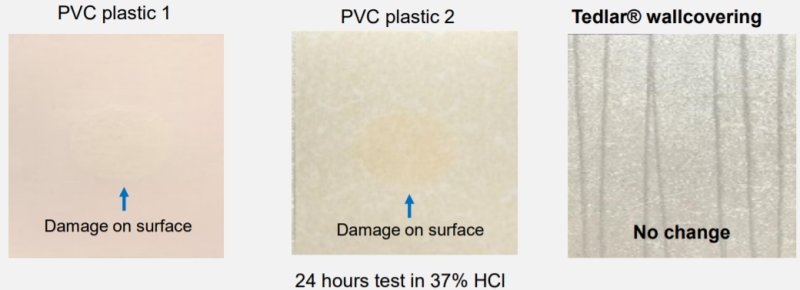
- Tedlar® Film Classification
Tedlar® PVF films are available as either biaxially oriented or unoriented cast film. The biaxially oriented film is stretched to various degrees in both the machine and transverse direction during manufacturing, imparting a range of different mechanical properties on the product depending on the amount of molecular orientation. The amount of orientation is described by the film type, listed as the last digit on the product code. The unoriented film, also known as ‘SP’ film, is cast onto a PET carrier web and is sold with the PET web attached. The Tedlar® film can be easily stripped from the PET carrier web. Films of Type 1 through 5 are oriented, while Type 8 is unoriented. Table 1 provides a summary of the various film types.
Type 3 films are the most commonly used films due to the balanced properties, including good strength and moderate shrinkage at elevated temperatures. Type 5 films are used when additional formability is needed in creating formed parts after lamination that require deep draws. Type 8 films have the highest formability and lowest shrinkage due to the nature of the processing and are used in the most demanding forming applications. In both Type 5 and Type 8 films, the reduced orientation leads to lower strength. Type 1 films are sometimes used when higher shrinkage is required, for example, to match the shrinkage of an underlying substrate during manufacture.
Table 1.The typical mechanical properties of various types of Tedlar® PVF films.
Film Type Orientation Shrinkage at 170°C Elongation at Break Strength Typical Use Type 1 High High Low High High shrinkage applications Type 3 Balanced Medium Medium Medium General applications Type 5 Low Low High Low High formability Type 8 (SP) None Low Very High Low Very high formability - Chemical Resistance Test II
Cleaning by solvent
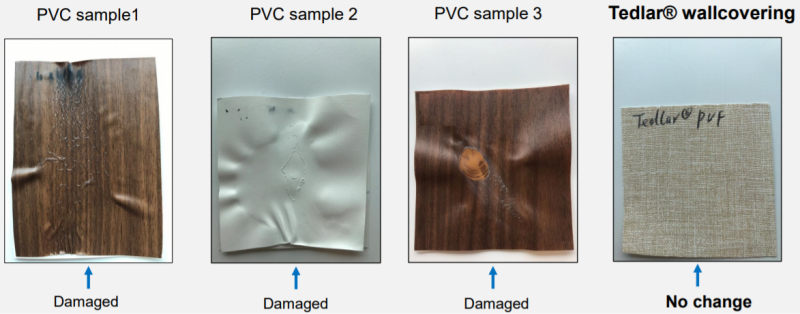
- Comparison to Other Materials
Paint Typical Type II Vinyl TEDLAR™ Wallcoverings Tile/Stone Painted Wall Panels Cleansability + +++ ++++ ++ ++ Durability + ++ +++ +++ ++++ Chemical Resistance - - +++ ++++ + Mold and Mildew + + ++++ + ++ Flame Resistance - ++ ++ ++++ +++ Installment Easy Medium Medium Difficult Medium Repair /Replacement Easy Medium Medium Difficult Medium Cost $ $$ $$ $$$ $$$ TEDLAR™ Wallcoverings offer excellent cleansability, durability, and chemical resistance with ability to be replaced easily when needed all while being cost effective versus tile and stone.
- Shrinkage of Tedlar® Films
Tedlar® oriented films will shrink when they are subject to heating without constraint. The amount of dimensional change depends most strongly on the temperature and orientation, with higher temperature and higher orientation causing the greatest shrinkage. This behavior is illustrated in Figure 2 and Tables 3 and 4 for some white and clear films with different orientation types. In general, film shrinkage increases as the type decreases from Type 8 to Type 1 films. In some instances, the films will expand slightly with initial heating in one of the two orthogonal in plane directions, then contract at higher temperature. This behavior will impact web handling through heated zones and precautions may need to be taken to properly spread and laterally tension the film during processing.
The force required to prevent the film from shrinking in either direction is relatively small. For example, at 180 °C, the typical force required to prevent shrinkage in 1 mil films are shown in Table 5.
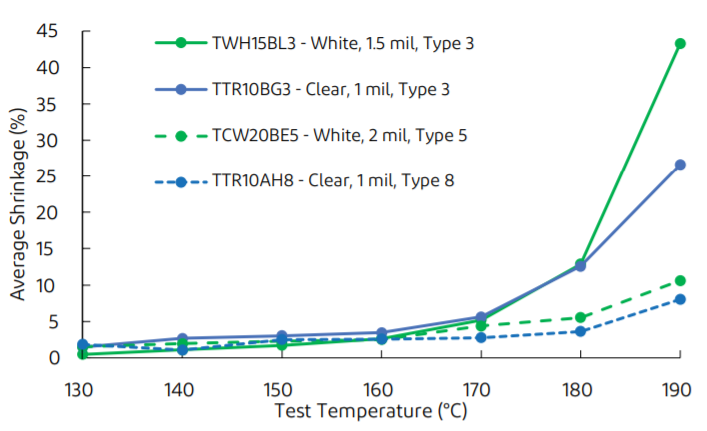
Figure 2: Typical machine and transverse direction shrinkage for white and clear films of Type 3, 5 and 8. The values provided are averages of machine and transverse direction shrinkage.
Table 3: Typical shrinkage as a function of temperature in both machine and transverse direction for three different white films.
Test Temperature (°C) TTR10BG3 Clear, 1 mil Type 3 Film Orientation MD TD 130 4 -1 140 5 0 150 6 -0.1 160 7 -0.2 170 10 2 180 16 9 190 28 25 Table 6: Films with typical mechanical data at various temperatures shown below
Film Type Temperature Range (°C) TTR10BG3 Transparent, 1 mil, Type 3 22 to 150 - Mechanical Properties at Elevated Temperature
There are several thermal transitions present in PVF film which can affect the mechanical properties. The lowest thermal transition temperature occurs in the glassy polymer at -80°C and is associated with local amorphous relaxation on short chain segments. At -15 to -20°C, a lower glass transition occurs which is believed to be related to relaxation of amorphous regions free from restraint of crystallites. An upper glass transition temperature occurs at around 40 to 50°C due to relaxation of amorphous regions which are under restraint by crystallites. Another transition occurs at around 150°C due to pre-melting relaxation in the crystallites. Finally, the polymer exhibits peak melting around 190 to 210°C.
Tedlar® PVF films performs well in temperatures ranging from approximately -72 to 107°C (-98 to 225°F), with intermittent shortterm peaking up to 204°C (400°F). Lower temperatures increase the strength and elastic modulus, and decrease the elongation of the film. Higher temperatures soften the Tedlar® film and decrease the amount of elastic response. The elongation of the film increases slightly with temperature, up to a maximum at around 100°C, and then the elongation typically decreases with increased heating. Since Tedlar® films contain no plasticizers, the mechanical properties are stable throughout exposure at elevated temperatures. The typical mechanical properties as a function of temperature from -40°C to 150°C are shown for a Type 3 clear, UV blocking film (TGP10BG3) and a Type 3 white film (TWH15BL3). The properties are shown from 22°C to 150°C for a variety of other white and clear films with various thickness and orientation.
TTR10BG3 (1 mil transparent film, type 3 orientation):
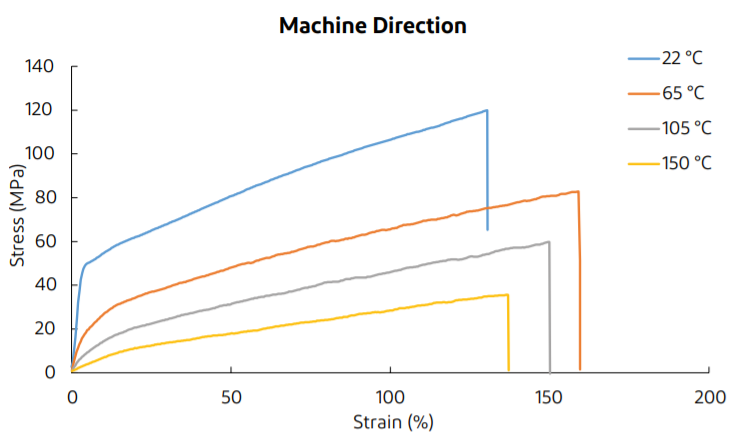
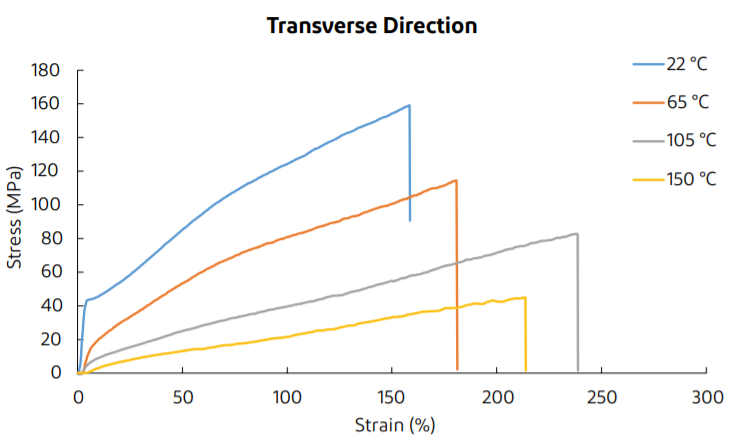
- Tedlar in Action
Buffalo Children’s Hospital, Buffalo, NY
Clear DuPont Tedlar film was recently selected to protect inspirational and uplifting art installations for the new Buffalo Children’s Hospital. Thanks to the surface protection provided by Tedlar, these special walls will stay beautiful and safe for years to come.
Omega Medical Center, Newark, Delaware
The challenge 30 years ago for the Omega Medical Center was to outfit its new premises in Newark, Delaware, for the long term. Maximizing return on investment by choosing medical and office equipment that would deliver value and performance over many years was an important part of the business plan; and selecting wallcoverings that could deliver the same longterm value was just as important. In the more than 30 years since the Tedlar protected wallcovering was installed, the Center has not experienced any problems such as staining, delamination, peeling or cracking as seen in some other wallcoverings.
In closing, Tedlar PVF film has unique properties that make it the ideal surface protection material for healthcare interiors. No other surface protective film can offer what Tedlar PVF films can offer: superior chemical resistance, exceptional cleanability, and compatibility with cleaning agents and disinfectants; while minimizing and slowing the growth of bacteria, mold and mildew.
- Example - Product Formation with Tedlar® PVF Film
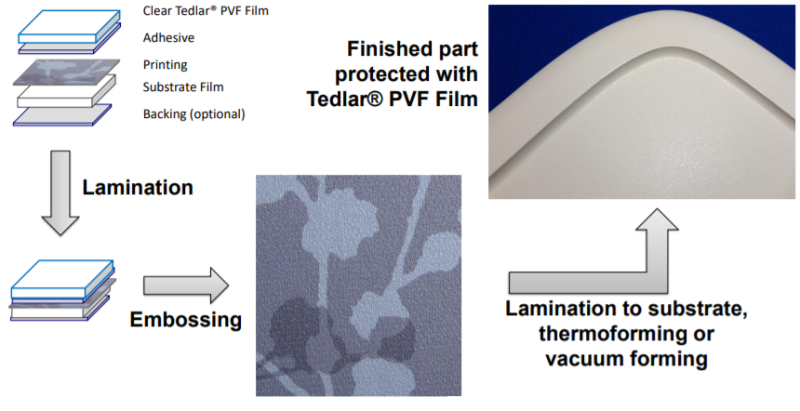
- Cleaning & Stain Resistance
All products were applied to Tedlar® PVF Film and allowed to set for 24 hours. Utilizing the following methods, all products were successfully removed from the Tedlar® PVF Film with no damage to the Tedlar® film.
Dry Cloth Cleaning Wet Cloth Cleaning Mild Detergent Solvent Baby Oil Human Sweat Oily Pen Ball Point Pen Acid Solutions* Urine Mercurochrome Surgical Fine Tip Marker Acetone Stomach Acid White Board Marker Permanent Marker Butanone Skin Moisturizer Lipstick Spray Paint Ethylalcohol Sunscreen Lotion Ketchup Glycol Iodine Shoe Polish Toluene Coffee or Tea Red Wine or Grape Juice Black Crayon Mustard Brake Fluid *Acid solutions include: acetic acid, 10% nitric acid, 20% hydrochloric acid, and 30% sulfuric acid
- Case Studies
Hospital in Changsha Guangxiu, Hunan China
Tedlar® PVF Interior Surface perfectly combine Tedlar® wallcoverings’ superior functionalities and durable metal board that enables enduring style and extreme cleanliness. The modular parts with installation steps to meet all the requirements for the healthcare environment construction.
Application area: patient room, public area, waiting area.
Hospital in Chengdu Xinan, Sichuan China
Modern healthcare environment creation for a private maternity hospital. Over 30,000 sqm Tedlar® wallcoverings laminated on fiber cement board pre-installed, covering doctor’s office, corridor, VIP patient room and labor room. Stain resistant, easy-cleaning and durable protection are key elements for owners of the hospital to choose Tedlar®. Panel system installation keeps onsite installation clean and efficient.
Application area: diagnostic office, patient room, labor room, ultrasound diagnosis area.
John R. Oishei Children’s Hospital, Buffalo, New York
Tedlar® is often used in applications that see high human traffic, such as the art installations in patient areas at Buffalo Children’s Hospital in New York. In 2018, many of the common areas of the hospital were redesigned to include inspiring graphics for children and their families. VSP Graphic group collaborated with The Martin Group and Kaleida Health to complete the installation. “After careful consideration, it was the anti-graffiti, resistance to mold and mildew, satin finish and second-to-none durability of Tedlar® that made it the best option for a medical environment like this,” Josh Szary, Director of Sales and Marketing for VSP said, “Children, families, the client and the designers are thrilled with the outcome.”